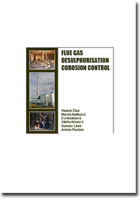Flue gas desulphurisation corrosion control

V. Číhal, M. Kadlecová, E. Kalabisová, Z. Krhutová, S. Lasek, A. Pourbaix
SVÚOM, Prague, 2010
ISBN 978-80-87444-00-9
The corrosion problems in flue gas desulphurisation (FGD) systems are analysed and optimum solutions are suggested for corrosion protection and for the choice of materials. The corrosion problems of gas desulphurisation plant go hand in hand with environmental concerns: there is evidence that sulphur dioxide, produced essentially by the combustion of fossil fuels, forms toxic substances that are hazardous to the environment.
The relationships between the dew point and the composition of the flue gas (SO2, S03, H2O, HCl, HF), the ash content, the composition of slurry and water (Cl- and F- concentrations), the velocity of the fluids and the formation of solid deposits are complex. Corrosion is a major problem especially for the quencher/absorber vessels and the inlet and outlet ducts. A very serious problem faced in the case of FGD scrubbers is localised corrosion (pitting and crevice corrosion, intergranular corrosion and stress corrosion cracking). Tests for pitting and crevice corrosion resistance use electrochemical methods (where the so-called pitting or breakdown potential and/or the repassivation potential is determined, in relation to several parameters). The electrochemical potentokinetic reactivation method (EPR) found acceptance for the non-destructive control of the degree of sensitisation to intergranular corrosion. While stress corrosion cracking occurs when salt sediments are retained on hot walls and tubes (e.g. of the reheater) or in crevices, attention is focused on the drop evaporation test which provides a good simulation of these conditions and is very severe.
Corrosion data from literature are presented together with data from actual examinations of FGD scrubbers damaged by corrosion. Their analysis provides a clear understanding of how various materials can be expected to behave in specific solutions under the operating conditions cencountered in the FGD scrubbing systems. Corrosion information is presented for a large number of stainless steels and alloys, and culminates in identifying groups of materials which show a promise of long-time performance: austenitic or ferritic-austenitic Cr-Ni-Mo stainless steels (possibly also alloyed with copper and nitrogen) and nickel alloys and/or titanium metal and titanium alloys.
Price: 750,- CZK + TAX (20%)






